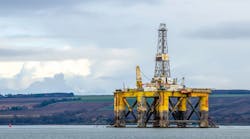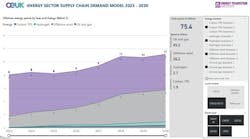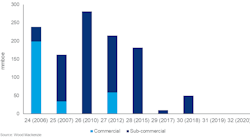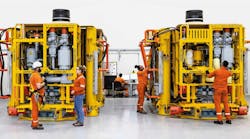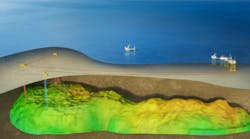Editor's note: This article first appeared in the July-August 2023 issue of Offshore magazine. Click here to view the full issue.
By Mathias Schioldborg and Jack Baxter, Rystad Energy
Investments on the Norwegian Continental Shelf (NCS) and the UK Continental Shelf (UKCS) will remain stable through to 2026, increasing marginally from $29.2 billion in 2023 to $29.4 billion by 2026. In Norway, expenditure will total $85 billion between 2023-2026, boosted considerably by the closure of its temporary tax regime and the subsequent project buildouts. In the same period, a total of $31 billion is set to be spent on the UKCS. In terms of exploration, a combined 53 exploration wells are expected to be drilled this year on the NCS and UKCS, with 41 and 12 wells to be completed, respectively. Investments on both the NCS and UKCS seem to have recovered from the pandemic downturn – particularly the UKCS from its historical low during 2021 – but despite sharing a continental shelf boundary, there are some key differences in the investment outlooks of the two countries.
NCS sanctioning outlook
Greenfield spending on the NCS is set for strong growth thanks to a temporary tax regime introduced in June 2020 which ran through to end-2022. The tax incentive was designed to maintain high, long-term investment on the NCS and ensure spending plans were not terminated due to the opaque market outlook brought about by the pandemic. Under the tax regime, new developments which submitted development and operations (PDO) plans between June 2020 and end-2022 would receive an uplift of 12.8% through to start-up.
Figure 1 shows the committed greenfield expenditure of NCS projects for developments approved between 2017 and 2024. Norwegian authorities typically approve new developments six months after their PDO has been submitted. The temporary tax regime resulted in an all-time sanctioning high on the NCS, sparking PDO submissions for 36 new developments in the last 2.5 years, most of which were delivered during a sanctioning rush in December 2022 before the tax window closed. The projects will see greenfield investment of $37.93 billion combined during their build-out phase, of which $27.96 billion has been committed to projects that had their PDO submitted last year. The portfolio of sanctioned projects within the tax window is expected to notably ramp up the short-term investment trend on the NCS.
Measuring by committed investments, two large-scale projects have been sanctioned under the temporary tax regime: the Aker BP-operated Yggdrasil hub and the Valhall PWP-Fenris development, both of which are located in the North Sea. The two are set for start-up in 2027 and are expected to cost $12.4 billion and $5.3 billion, respectively. Also set to benefit are two pure gas developments: Equinor’s Irpa and Shell’s new subsea compression system at the Ormen Lange field, sparking investment of $1.57 billion and $1.29 billion, respectively. The remaining tax window portfolio is dominated by small-scale, subsea tieback projects which are expected to trigger only moderate investments on the NCS through their development phases. Although Equinor’s Ringvei West cluster and Grosbeak discovery are in line for approval next year, the short-term sanctioning outlook on the NCS will be subdued now that the temporary tax regime window has closed.
UKCS investment outlook
Capital investment on the UKCS is set to be far lower than in Norway, with combined greenfield and brownfield spend totaling $30 billion between 2023 and 2026, with many new projects hailing from small independents typically focused on niche or late-life developments. Investment is set to peak at $8 billion in 2025, before declining over subsequent years, with spending unlikely to return to pre-pandemic levels.
Approximately $18 billion worth of projects are expected to be sanctioned on the UKCS from 2023 to 2026, with Hartshead Resources’ Anning and Somerville project and BP’s Murlach set for sanctioning this. In 2024, there is potential for the two largest undeveloped finds on the UKCS, Cambo and Rosebank, to be approved. After continued setbacks, Cambo could be back in play, with the North Sea Transition Authority (NSTA) extending the license by two years in March 2022. Soon after, Ithaca Energy announced its acquisition of Siccar Point Energy, taking an operating stake in Cambo and a non-operating stake in Rosebank. In May 2023, Shell officially launched the sale process for its stake in the project, acting as a potential hurdle to approval should the process end up being lengthy.
Rosebank appears to have a clearer pathway for approval, with Equinor able to take a final investment decision (FID) once the Offshore Petroleum Regulator for Environment and Decommissioning (OPRED) approves the project’s environmental statement. The North Sea Transition Authority (NSTA) will be next in the chain to allow the progression of the find, and should this go smoothly, Rosebank would be on track for first oil. Ithaca Energy regards both Rosebank and Cambo as the “most strategically important discoveries in the UK North Sea,” making the case that, if “operated without the need for routine flaring or venting of hydrocarbons,” they would be important stepping-stones in the UKCS’s journey through the energy transition and aid UK energy security. Meanwhile, Equinor believes the project “will bring much needed energy security and investment in the UK while supporting the UK’s net zero target.”
UKCS fiscal review
In May 2022, the UK government announced a windfall tax known as the Energy Profits Levy (EPL) on UKCS producers. The levy started as an additional 25% tax on top of the previous headline tax rate of 40%, which is comprised of a 30% corporate tax and a 10% supplementary charge set to end in 2025. However, in November 2022 with prices still at high levels, the UK government increased the levy to 35% and extended the scheme to March 2028.
Many on the UKCS, especially those with portfolios weighted towards cash-generating producing assets, have been hardest hit by the scheme. Companies such as Harbour Energy and APA Corporation have cut back planned operations, with the former announcing a swathe of job cuts and the latter suspending all new drilling on the UKCS. Others have benefitted from the UK government’s new ‘Investment Allowance,’ which incentivizes companies to invest in new projects by offering significant cost relief. This new allowance has the potential to fast-track several development-ready projects on the UKCS and improves the economics of many pre-development assets if companies are willing to commit capital prior to the end of the EPL.
Until the recent amendment, the EPL was set to end in March 2028, regardless of whether prices fell from the high levels which triggered the windfall tax in the first place. When the EPL was introduced in May 2022, Brent averaged $113 per barrel with the UK gas price sitting around 105 pence ($0.70) per therm, though last month, prices averaged $75.47 per barrel and 70 pence per therm, respectively. In Rystad Energy’s base case, oil prices could fall to below the desired threshold, but gas prices will be far from the required level. According to the UK’s Office for Budget Responsibilities’ (OBR), UK gas prices will not meet the threshold either, though it is worth noting that their forecast does not continue through to 2028.
Of course, while forecasts suggest it will be unlikely, it is not impossible for the conditions to be met. Sustained levels of lower prices would inherently remove any ‘windfall’ profits for companies on the UKCS, with free cash flow reducing under an early sunset, despite the 35% tax now removed. Additionally, assuming the investment allowance is removed, some companies will lose out on tax saving for expenditure committed to new projects.
While this latest amendment to the fiscal regime is a step in the right direction, potentially buoying investor sentiment, the industry likely hoped for more. The UK government’s claim that this new measure will protect energy security and jobs seems empty, given there is a low chance the EPL will sunset early. Even if the levy did end early, prices would be at a low enough level for companies to be generating significantly lower revenues, nonetheless.
NCS production outlook
Figure 2 shows the expected production outlook for Norway split by hydrocarbon type and tax regime, from 2020 to 2030. This year, we expect a small production ramp-up to 4.3 million barrels of oil equivalent per day (boe/d) from 4.33 million boe/d last year, with total production split almost equally between gas and liquids (oil, condensate and NGL). The year-on-year increase is driven strongly by enhanced production from the giant Johan Sverdrup oil field, which launched its second phase in December 2022 and reached plateau production of 220,000 boe/d in May 2023.
Looking ahead, production is expected to remain steady at current levels towards 2030. A considerable share of large, producing fields will gradually enter their decline phases in the medium term, such as Troll, Oseberg and Aasgard. However, production stemming from projects sanctioned under Norway’s tax package remain on track to postpone the production decline on the NCS – both for liquids and gas. The majority of added volumes will stem from Aker BPs Yggdrasil hub, Valhall PWP-Fenris development and from the Skarv Satelites project (Alve North, Idun North and Orn), as well as Equinor’s Irpa and Breidablikk, all which are set to come online between 2025 and 2027. Added production from the tax window projects will peak at 857,000 boe/d in 2028, split by 420,000 boe/d for liquids and 437,000 boe/d for gas – yielding a total production from the NCS of 4.3 million boe/d. Given the reduced aggregate supply to Europe in the last two years, especially gas, the additional volumes spurred by Norway’s temporary tax regime will prove useful in maintaining its position as a provider of energy to Europe towards 2030.
UKCS production outlook
The relative maturity of the UKCS oil and gas sector has led to subdued production in recent years, encouraged infrastructure-led exploration (ILX) activity and attracted small independents which are typically focused on niche or late-life developments. After falling to near 50-year lows in 2021, total UKCS production increased by just 3% last year, with a handful of projects starting up late in 2021 and through 2022 failing to materially offset the decline in production from mature fields. Among the projects that came online in 2022 were IOG’s Saturn Banks Phase 1, as well as Ithaca Energy’s Abigail and Tailwind Energy’s Evelyn assets. Production will fall to under 1.3 million boe/d this year, the lowest level since 1976. The start-up of Shell and NEO’s Penguins, Shell’s Pierce gas blowdown and Eni’s recently acquired Seagull will fail to quell a country-level decline this year. Even with potential volumes from Rosebank and Cambo towards the latter end of this decade, UKCS production will continue to decline (Figure 3).
About the authors
Jack Baxter is an upstream analyst at Rystad Energy, responsible for coverage of UKCS operations. Prior to joining Rystad Energy, Baxter worked as an analyst at Westwood Global Energy Group. He holds an MSc in petroleum geoscience from Royal Holloway University, UK.
Mathias Schioldborg is an upstream analyst at Rystad Energy, covering activity on the NCS. He has worked with production forecasting, company coverage and tax models. He holds an MSc in economics from the University of Bergen, Norway.






